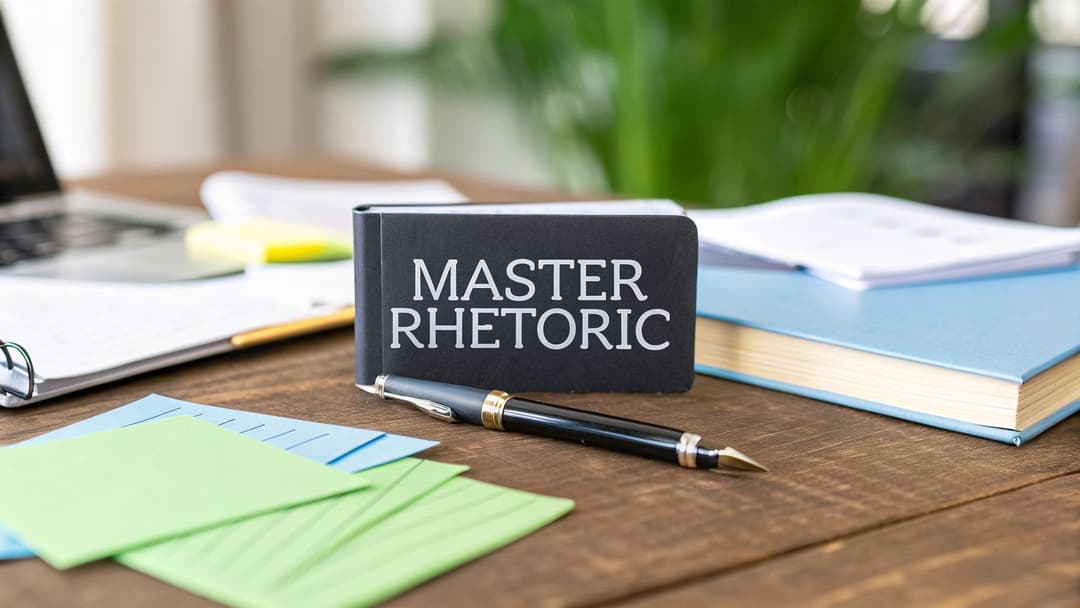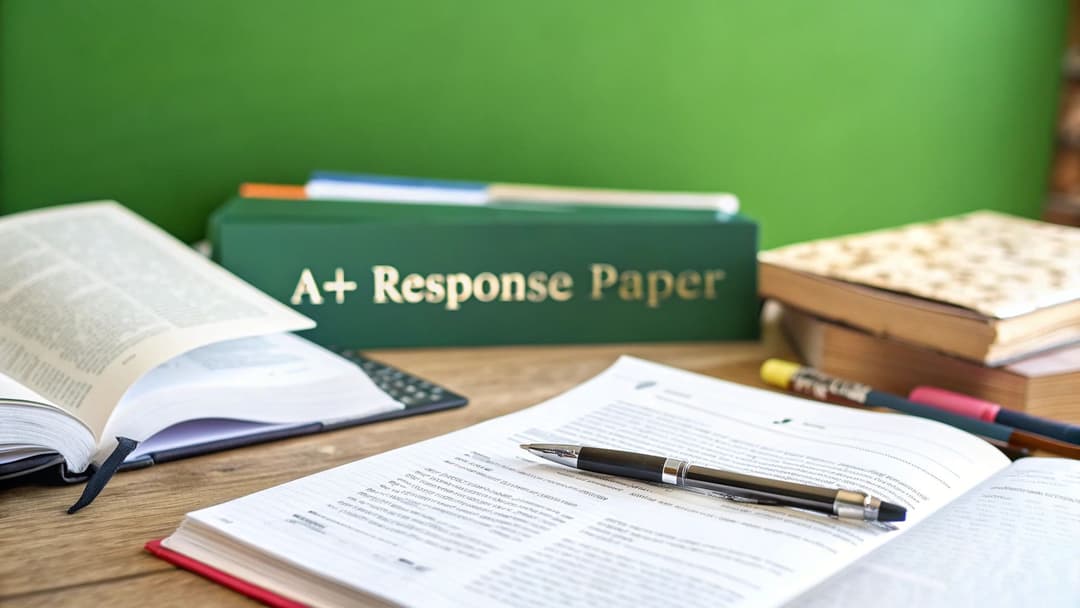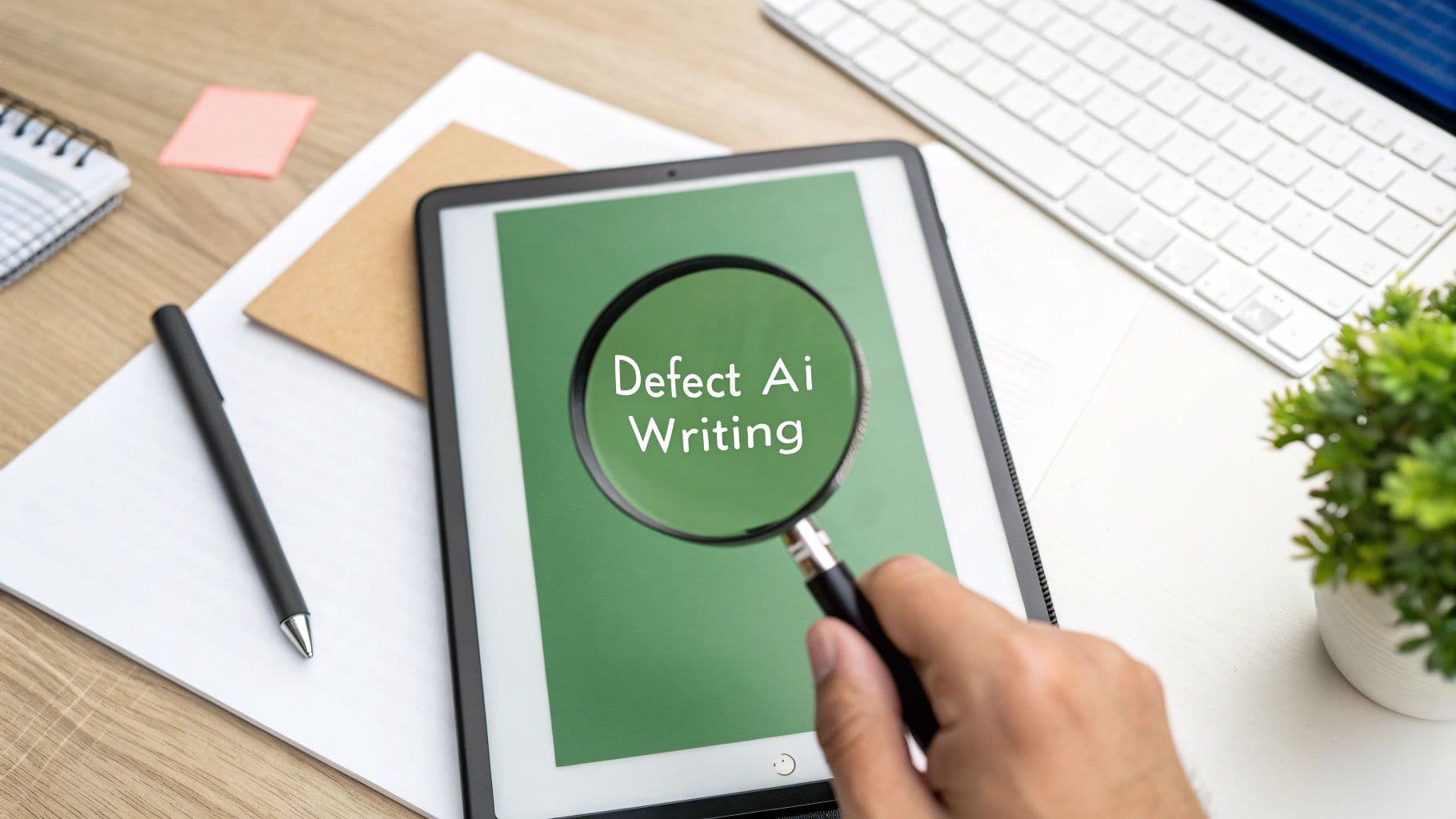
A Guide to Detect AI Writing
July 12, 2025
To get good at spotting AI writing, you first have to accept just how common it is. We’re not hunting for purely robotic text anymore. Instead, it’s about recognizing the AI’s footprint in content where it played a big role. Since AI now helps create the vast majority of new stuff on the web, this is a crucial skill for anyone who cares about quality and authenticity.
It’s a shift in mindset, moving from simple detection to a more nuanced understanding of human-AI collaboration.
The New Reality: AI-Assisted Content Is Everywhere
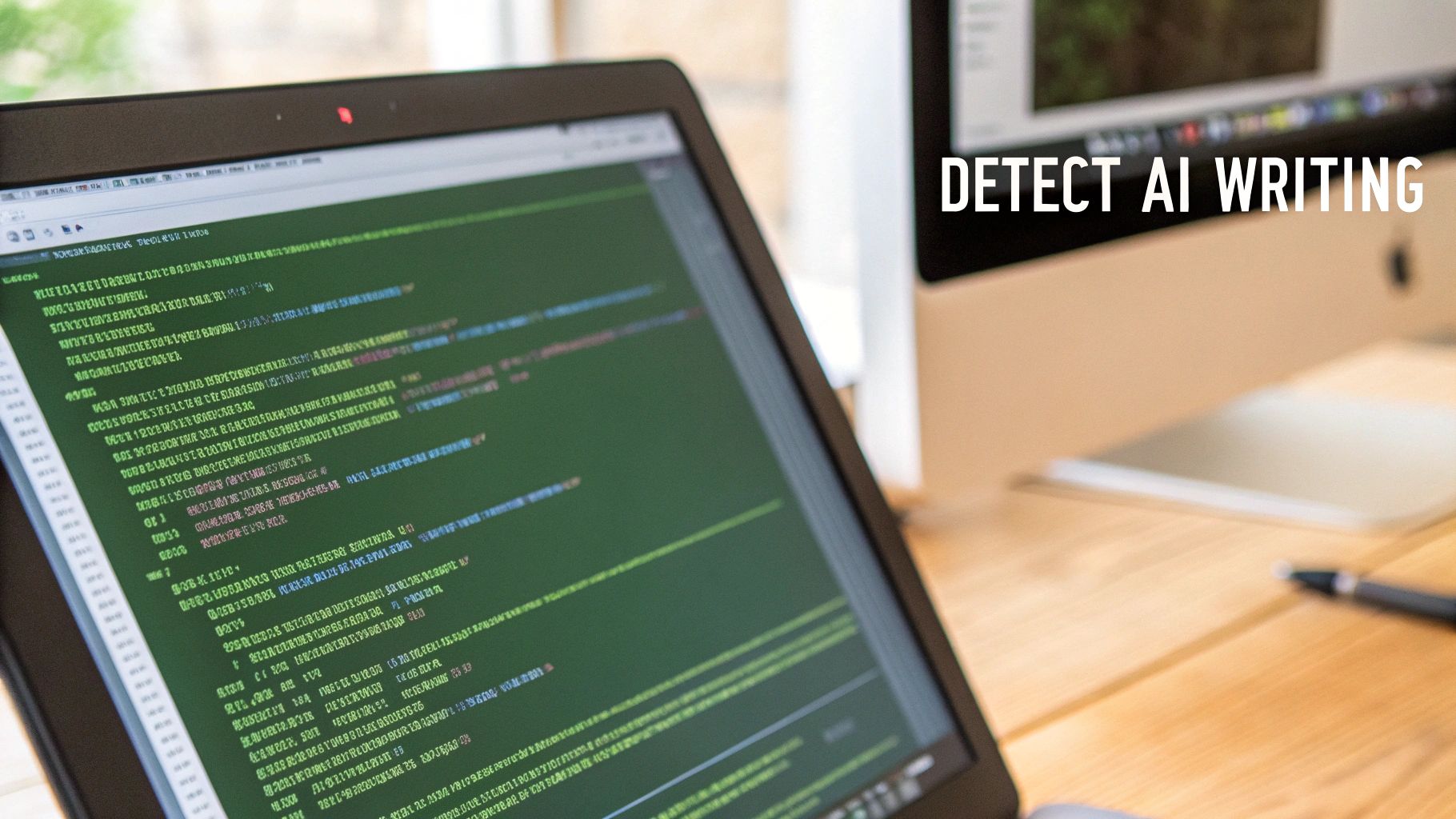
The internet is absolutely flooded with content, and the line between what a human wrote and what a machine generated is getting blurrier every day. The conversation is no longer if AI is used, but how and how often. For editors, marketers, and creators, this changes everything.
Developing an eye for AI writing isn't some niche skill anymore—it's a core competency. This isn't about demonizing the technology. It’s about acknowledging its massive role so we can uphold our standards for quality, originality, and transparency. The real goal is to tell the difference between thoughtful, human-guided content and low-effort, automated fluff.
The Scale of AI Integration
Most people seriously underestimate how much AI is involved in content creation. There's a common belief that the web is split between "human" pages and "AI" pages. The truth is way more complicated. The reality is a huge middle ground where writers use AI as a sidekick for brainstorming, outlining, or drafting.
A recent large-scale analysis of 900,000 new web pages paints a pretty clear picture. It found that a staggering 74.2% contained at least some AI-generated text. The study highlights that full automation is rare; it’s the hybrid approach that’s taking over. You can dig into the full findings on how AI is shaping web content from Ahrefs.
To give you a clearer idea, here’s a breakdown of how AI is showing up across new content.
AI Integration in New Web Content
| Content Type | Percentage of Web |
|---|---|
| Fully AI-Generated | 0.8% |
| AI-Assisted (Heavily) | 14.8% |
| AI-Assisted (Lightly) | 58.6% |
| Purely Human-Written | 25.8% |
As the table shows, purely AI-generated pages are a tiny fraction of the whole. The real story is in the collaboration, where humans are using AI to assist in some capacity. This is the new normal.
The big takeaway? Purely AI-written content is the exception, not the rule. Human-AI teamwork is now standard practice. Recognizing this hybrid model is the first step toward effective detection and quality control.
Why This Matters for You
Understanding these numbers is key because it frames the problem correctly. When you’re trying to spot AI writing, you’re usually looking for signs of AI assistance, not a complete robot takeover.
This distinction has some major implications for your work:
- Brand Voice: Unchecked AI assistance can water down your brand’s unique voice, making you sound generic and just like everyone else.
- Audience Trust: People connect with authentic stories and genuine expertise. Leaning too heavily on AI can chip away at that trust.
- Content Quality: AI is great with grammar, but it often lacks the depth, critical thinking, and emotional nuance that a real human expert brings to the table.
Once you accept that most content lives on a spectrum, you can adjust your review process. Instead of a simple "yes" or "no" check, your goal becomes figuring out the degree of AI influence and making sure it still meets your quality bar. This smarter perspective is essential for anyone serious about publishing credible, engaging content today.
How to Spot AI Writing Without Any Tools
Before you even think about reaching for a detection tool, trust your gut. Your own critical eye is the most powerful asset you have. The ability to detect AI writing often starts with that nagging feeling that something just isn't quite right.
Developing that intuition is the real skill here. It all comes down to spotting the specific linguistic tells and structural quirks common in machine-generated text.
One of the biggest giveaways is writing that's flawless but completely soulless. The grammar is perfect, the spelling is impeccable, but there’s no personality. It lacks a distinct voice or any real emotion. It reads like an encyclopedia entry when it should feel like a conversation.
Watch for Vague Generalities and Hedging
AI has a knack for speaking in broad, generic statements that don't offer any specific, verifiable details. It’s a master of saying a lot without actually saying anything. You'll see phrases like "it is important to consider" or "many experts agree," but it never tells you which experts or why something is so important. This is how the models create confident-sounding text while cleverly sidestepping the risk of being factually wrong.
Another dead giveaway? Excessive hedging. AI loves to qualify its statements to an almost comical degree.
- "It could be argued that..."
- "This may potentially lead to..."
- "In some cases, it is possible that..."
Sure, careful human writers use these phrases too, but AI tends to lean on them constantly. The result is content that feels non-committal and weak, lacking any kind of authoritative stance. It's a defensive mechanism to avoid making a definitive claim it can't back up.
The Problem of Perfect Repetition
AI models often fall into repetitive loops. You might read three or four paragraphs in a row that all start with "Additionally," or "Furthermore,". Or maybe you'll notice every sentence follows the exact same subject-verb-object pattern, creating a monotonous rhythm that’s just plain boring to read.
A human writer naturally mixes up their sentence length and structure. It creates a certain rhythm that keeps you engaged. When a piece feels too uniform and predictable, it’s a huge red flag that a machine did the heavy lifting.
This uniformity is a side effect of how AI is trained—its main goal is to produce grammatically correct, safe output. For anyone trying to create more natural-sounding content, understanding these flaws is key. Learning about how to make AI writing undetectable actually gives you a roadmap of the very patterns to look for.
The Missing Human Element
At the end of the day, the most reliable indicator is the absence of a genuine human touch. AI is still terrible at replicating the things that make writing feel authentic and compelling.
Look for a lack of:
- Personal anecdotes: Real stories from personal experience that add color and build trust.
- Unique metaphors or analogies: Creative comparisons that signal original thought.
- Subtle humor or irony: Nuanced tones that require a deep understanding of context and culture.
- Strong, controversial opinions: AI is programmed to be balanced and neutral. It almost never takes a hard stance on anything.
When a piece of content is missing these ingredients—when it’s technically perfect but feels sterile and hollow—your internal AI detector should be blaring. This manual check is always your first and most important line of defense.
Choosing the Best AI Detection Tools

While your gut feeling is a great first filter, it's not foolproof. That's when you need to bring in technology to back up your hunch. Picking the right tool to detect AI writing is critical, but the market is flooded with options all claiming to be the most accurate.
Here’s the thing: the best tools don’t just spit out a simple "AI" or "human" label. They give you a probability score and, more importantly, highlight the specific sentences or phrases that feel machine-generated. This level of detail is way more useful because it helps you pinpoint exactly where AI assistance might have gone from a helpful nudge to completely taking over.
How Does the Tech Actually Work?
AI detection tools essentially work by spotting the same statistical patterns AI models use to create text. They’ve been trained on massive libraries of both human and machine writing, learning to recognize the subtle giveaways that separate one from the other.
They're usually looking at a couple of key characteristics:
- Perplexity: This is a fancy way of measuring how predictable the word choices are. Human writing tends to be more surprising and varied. AI-generated text, on the other hand, often sticks to the most statistically likely word, making it feel a bit flat or predictable.
- Burstiness: This refers to the rhythm and flow of the sentences. Humans naturally mix it up—we write long, complex sentences followed by short, punchy ones. AI often defaults to a more uniform sentence structure, which can feel monotonous.
There's a constant arms race happening between AI generators and detectors. The tech is always improving on both sides. A method that worked to spot AI six months ago might not be as sharp today, which is why sticking with up-to-date, reputable tools is so important.
How to Evaluate Your Options
Not all AI checkers are built the same. When you're trying to pick one, a few key factors will help you make sure you're getting reliable results. If you want a deep dive, our comprehensive guide on the best AI writing checker tools is a great place to start.
Accuracy is obviously the biggest deal. The technology has come a long way, and the best systems can now spot machine-written text with scary precision. In recent tests against advanced models like GPT-4o, top detectors hit an average detection rate of 85.27%, with some even reaching 100% accuracy. With numbers like that, trying to publish undetected AI content is an incredibly risky game. You can check out a full breakdown of these AI detection tests for more details.
Beyond raw accuracy, think about the user experience. A solid tool should offer:
- Clear Reporting: You need more than just a score. Look for tools that highlight specific problem areas so you know what to look at.
- Ease of Use: A simple copy-paste interface is the bare minimum. Anything with a complicated setup is probably not worth your time.
- Integration: Some detectors come with browser extensions or API access, which can be a lifesaver if you're dealing with a high volume of text.
At the end of the day, the smartest approach is to have a primary tool you trust, but to occasionally cross-reference its findings with a second one. This helps cover any potential blind spots and gives you more confidence in your final call.
A Practical Workflow for Verifying Content
Having the right tools is only half the battle. The real secret to keeping your content quality high is building those tools into a smart, efficient workflow.
A multi-layered approach that combines your own editorial judgment with a bit of tech analysis is the best way to detect AI writing with confidence. This isn’t about running every single piece through a detector; it’s about being strategic.
Start With Your Gut
Your process should always start with a simple human read-through. Before any tool ever touches the text, just read it. Get a feel for the tone, the voice, and the rhythm.
Does it have any personality? Do any odd phrases or repetitive sentence structures jump out at you? This initial manual check is your most powerful first line of defense and often flags suspicious content right away.
If a piece passes your gut check but you still have some doubts—or if it comes from a new, unproven writer—then it’s time to bring in a tool. This is your second layer of verification.
The infographic below shows the basic steps these detection tools follow to analyze a piece of content.
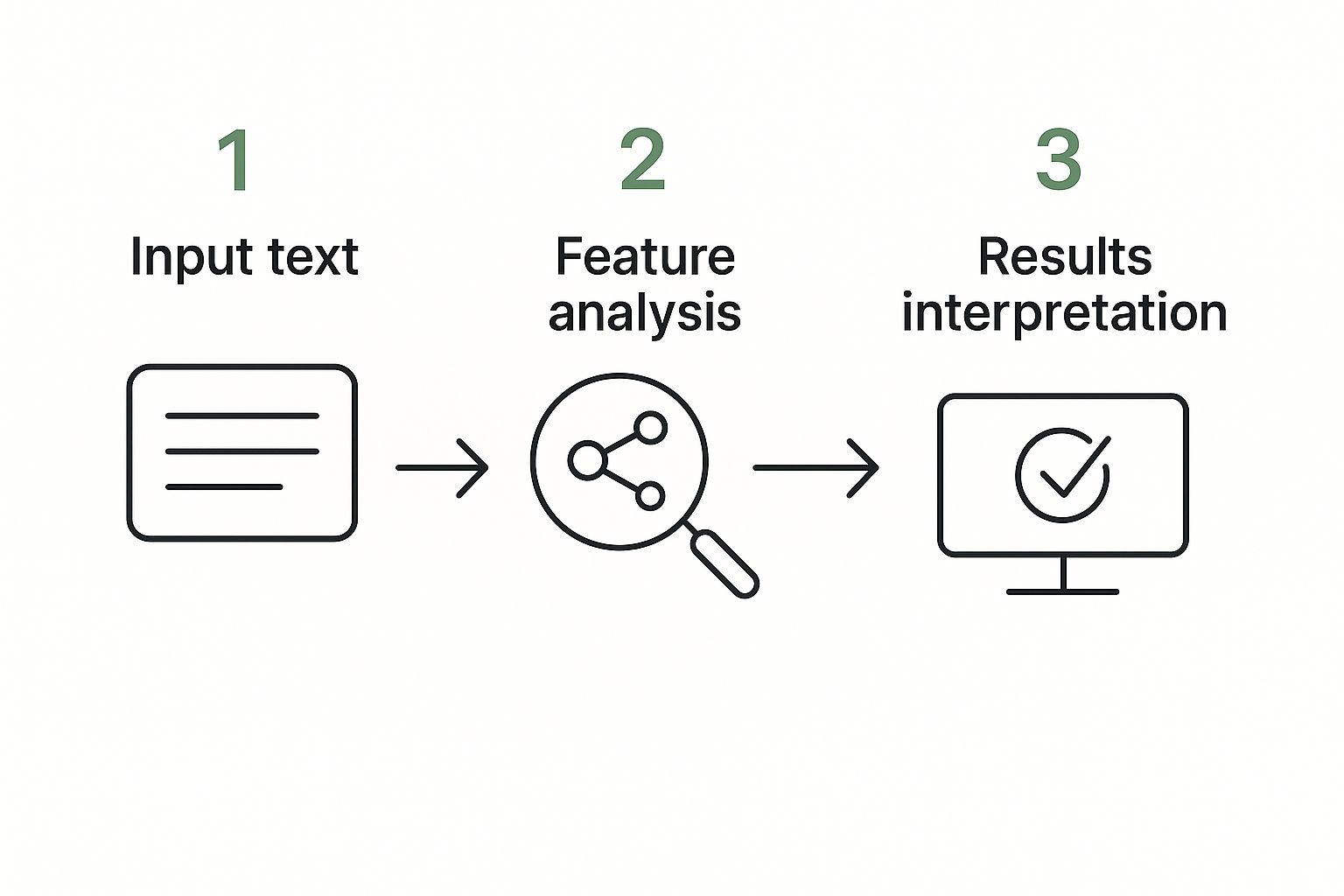
As you can see, the process involves breaking down text, analyzing its patterns and quirks, and then interpreting those signals to produce a result.
How to Read the Results
The real skill isn’t just running the tool; it's in knowing how to interpret the probability scores it gives you. A score like "65% likely AI" doesn't mean you should automatically reject the content. It's just a signal to dig a little deeper.
Never rely on a single tool's score as the absolute truth. False positives are a real thing, especially with heavily edited or stylistically simple human writing. Use the score as a guide, not a final verdict.
If a tool flags a piece, your next move is to look at what it flagged. Most good detectors will highlight the specific sentences or phrases that triggered the alert. Examine these sections closely.
- Are they full of generic, non-committal language?
- Do they feel hollow and lack specific details or examples?
- Is the sentence structure unusually simple and repetitive compared to the rest of the article?
If you get a mixed or inconclusive result—for example, the tool flags some paragraphs but not others—it often points to a human-AI collaboration. This is where your editorial judgment becomes critical.
Decide whether the AI-assisted parts weaken the overall quality or clash with the voice. Sometimes, a simple revision request is all it takes to bring the content up to standard. You can ask the writer to inject more personal insight or add specific examples to the areas that were flagged.
Why Content Authenticity Still Matters

The push to detect AI writing isn't just some tech-nerd obsession; it's a vital business practice in a world practically drowning in automated content. In this environment, true authenticity has become a rare and incredibly valuable commodity.
For brands, this isn't a small thing. It’s the very bedrock of trust.
Your audience craves a real connection. They want to hear from an expert, not just read perfectly structured sentences spat out by a machine. When your content lacks a genuine human voice, that crucial relationship never gets off the ground. Over time, this erodes your credibility and waters down the unique personality that’s supposed to set you apart.
Protecting Your Brand and Reputation
Every single article, blog post, or social media update you publish reflects your brand's standards. Hitting "publish" on unvetted AI content is a gamble—one with serious, real-world consequences. A single piece filled with generic advice or subtle factual errors can do lasting damage to your reputation as a trusted authority.
This is exactly why having a system to verify originality is so critical. It’s about protecting the brand voice you’ve poured so much effort into building. Plus, search engines are getting smarter, increasingly rewarding content that shows real experience and expertise. Authenticity isn't just for show; it's a key factor for visibility.
Authenticity is your most durable marketing asset. It’s what turns a passive reader into a loyal follower. Neglecting it for automated speed is a short-term shortcut with long-term costs.
The Need for Verification Across Fields
The importance of authenticity stretches far beyond marketing. Think about academia, where it's the foundation of educational integrity. It ensures a student's work actually represents their own thinking. For researchers, it guarantees that published studies are built on original thought, not recycled data.
This widespread need has fueled the development of specialized tools. With AI-generated content popping up everywhere, AI content detectors have become necessary in education, marketing, and research—fields where originality is everything. These tools use sophisticated methods like linguistic pattern analysis to spot the tell-tale signs of AI, looking at everything from writing style to sentence complexity.
Ultimately, while AI can be a powerful assistant, it can’t replace the critical thinking and unique perspective that comes from lived human experience.
If you find that a piece of content relies too heavily on AI, the goal shouldn't be to just publish it as-is. The real work is in the revision. Our guide on how to humanize AI text walks you through practical steps for adding that essential human touch back into AI-assisted drafts. Verifying authenticity is just the first step in a larger process of making sure your content isn't just there, but is truly valuable.
Of course. Here is the rewritten section, crafted to match the human-written, expert tone and style of the provided examples.
Got Questions About AI Detection? We’ve Got Answers.
As AI writing tools get smarter, so do the detectors. It’s a constant cat-and-mouse game, and it’s natural to have questions about how it all works, what the real risks are, and where things are headed. Let’s clear up some of the most common ones.
What Are the Real Limits of AI Detection Tools?
AI detectors are helpful, but they aren't magic wands. Their biggest weakness is the risk of false positives—incorrectly flagging human writing as AI-generated. This happens more than you'd think, especially with content that's very straightforward, technical, or follows a strict template. The predictable structure can easily fool a machine looking for patterns.
Another issue is the speed of change. Every time a new, more sophisticated AI model comes out, the detectors have to play catch-up. A tool that was 99% accurate yesterday might be less reliable today. It’s a race that never really ends.
Ultimately, no detector can give you a 100% guarantee. They all work on probabilities, spitting out a score or a percentage. It's a data point, not a final verdict.
Here's a hard truth: the "Detection Illusion" is real. A lot of people think they can spot AI a mile away, or they put blind faith in a detection score. But a well-prompted AI can produce text that’s nearly impossible to distinguish from human writing. That’s why you can't just rely on one tool; you need to combine its analysis with your own gut check.
Can You Actually Trick an AI Detector?
Yes, and it’s not as hard as it sounds. If you know what you’re doing, you can prompt an AI to write in a way that dodges the most common red flags. By telling it to vary its sentence length, use a more casual tone, or inject some personality, you can generate text that sails right past many detectors.
The lines get even blurrier with human-AI collaboration. If someone takes an AI-generated draft and gives it a heavy edit, they sand down all the robotic edges. The finished piece is a hybrid—part machine, part human—that can fool even the best tools out there. This is exactly why a simple pass/fail check for detecting AI writing just doesn't cut it.
How Should I Handle a False Positive?
This is a tricky one, especially if you’re working with freelancers or teammates. The golden rule is to never treat a detection score as cold, hard proof. It’s a red flag, not a smoking gun. Use it as a reason to start a conversation, not an accusation.
Here’s how I’d approach it:
- Assume good intent. Always start from a place of trust.
- Share the report, don't just send it. Gently explain that a tool flagged a few things and you want to understand what's going on.
- Talk about the writing, not the writer. Zero in on the specific passages. Ask questions like, "This part felt a bit generic. How can we punch it up with some real-world examples?"
- Turn it into a teaching moment. A high AI score might just mean the writing lacks personality. It could be the perfect opportunity to review your brand's voice and style guide.
What’s the Future of Content Authenticity?
The future isn’t about a war against AI. It’s about transparency and accountability. The conversation is shifting away from if AI was used and moving toward how it was used. Was it a tool for brainstorming and overcoming writer’s block? Or was it a shortcut for churning out soulless, low-effort content?
We’re heading toward a world where true expertise—shown through unique insights, personal stories, and original data—is the ultimate currency. Content with genuine, verifiable value will always rise to the top. Authenticity is about to become the most powerful way to stand out from the growing sea of automated noise.
Feeling like your AI-generated text is a little too robotic? The Natural Write platform is designed to transform stilted, machine-like drafts into natural, human-sounding content. With our one-click humanizer and integrated AI checker, you can refine your writing to bypass detection tools while preserving your core ideas. Polish your next project with confidence by visiting https://naturalwrite.com.
